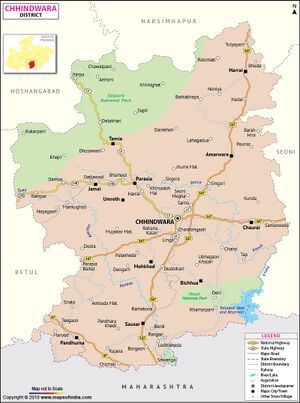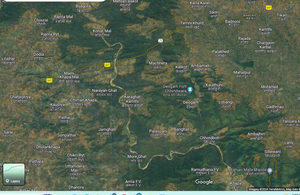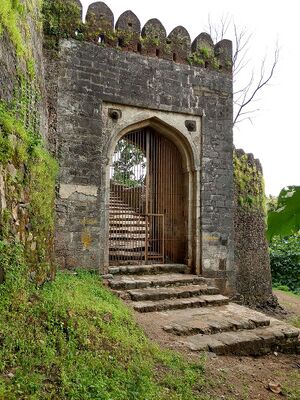Deogarh Chhindwara
See Deogarh for similarly named villages at other places.
| Author:Laxman Burdak, IFS (R) |


Deogarh (देवगढ) is a village and site of ancient fort in Mohkhed tahsil in Chhindwara district in Madhya Pradesh. It is located 42 km southwest of Chhindwara, picturesquely situated on a crest of the hills. The fort is in between a dense forest as well as deep moat. Author (Laxman Burdak) Visited Deogarh Fort on 07.03.1990.
Variants
- Devgarh (देवगढ़)
- Devagadha (देवगढ़) (AS, p.443)
- Deogarh Fort (देवगढ किला)
Jat Gotras Namesake
- Dev (Jat clan) = Devgarh (देवगढ़). Deogarh (देवगढ) is a village and site of ancient fort in Mohkhed tahsil in Chhindwara district in Madhya Pradesh. It is located 42 km southwest of Chhindwara, picturesquely situated on a crest of the hills. The fort is in between a dense forest as well as deep moat. Author (Laxman Burdak) Visited Deogarh Fort on 07.03.1990.
Location

Devgarh is a Village in Mohkhed Tehsil in Chhindwara District of Madhya Pradesh State, India. It belongs to Jabalpur Division . It is located 20 KM towards South from District head quarters Chhindwara. 245 KM from State capital Bhopal. Devgarh Pin code is 480107 and postal head office is Umaranala. Devgarh is surrounded by Chhindwara Tehsil towards North , Parasia Tehsil towards North , Bichhua Tehsil towards East , Sausar Tehsil towards South.[1]
The Kanhan River flows about 5 km to the south of Deogarh Fort where it humbly receives an insignificant tributary.
Author Visited Deogarh Fort
Author (Laxman Burdak) Visited Deogarh Fort on 07.03.1990 as Divisional Forest Officer West Production Division. I started from tour on 07.03.1990 from Chhindwara at 10.00 am for the Inspection of Lavaghoghari Production Range timber felling coupes – Coupe Numbers 13 & 68 Deogarh along with Range officer – RK Saxena and his field staff. After inspection of the forests I Visited Deogarh Fort. I used to visit historical places located in the forest, which are generally ignored by tourists and even archeological staff, being in very remote areas. I was informed by the staff based on their oral traditional knowledge that this fort was constructed in 17th century by Peshwas. Coins are found here frequently bearing mark of Balaji Rao Peshwa. On a hill top within the forest is situated this ruined fort in about 5 ha. The structures have been destroyed but one structure “Nagara Khana” is still present. From the top of this is visible Rang Mahal. There is one Masjid also. The Fort and Rang Mahal are said to be internally connected by a surang. I could not get its ancient history. Bases on names of places in Chhindwara I am of opinion that It was built by Nagavanshi Jats.
-
Deogarh Chhindwara.07.03.1990
-
Deogarh Chhindwara.07.03.1990
-
Deogarh Chhindwara.07.03.1990
Deogarh Fort - Archaeological Place
This famous historical fort of Devgarh is situated 24 miles south of Chhindwara beyond Mohkhed. The fort is built on a hill which is fortified by a deep valley clothed with dense reserve forest. The fort is approachable upto its foot by motor road. The nature is bountiful here. It was the capital of ‘Gond’ empire till 18th Century and had its glory and glitter at that time. Now, one can find only the delapitated remains of the mighty kingdom and fort. Devgarh kingdom was considered to be the largest tribal kingdom in Central India. The archeological structures like palace, fort and other buildings make it a beautiful tourist place and remind us of the past glory. It is believed that there was a secret underground passage connecting Devgarh to Nagpur, which was used by the kings to escape at times of emergency.
Among the remnants of the fort the main gate facing North speaks of its past glory. Besides this, there remain Nagarkhana, a place of cattle drum, scattered remnants of the fort walls and ruins of the Darbar Hall. There is a curious reservoir named ‘Mortitanka’ at the top of the fort. It is said that at one time the water stored in the reservoir remained so clear that one could have a clear view of even a coin lying at its bottom. It is believed to be built by King Jatava of Gond Dynasty. The design of Devgarh fort is much akin to Moghul architecture, and hence some historians are of the view that the fort was built by Bakhta Buland who succeeded King Jatava. At present Devgarh village is a small inhabitance. The ruins at this place speak of its past glory.
Source - https://chhindwara.nic.in/en/cultural-tourism/
History
The Deogarh Fort or Devgarh Fort is one of the very old fort situated in Madhya Pradesh, India. It was the capital of a Gond Dynasty and is located in the present day town of Devgarh, at a distance of 42 km from the district headquarter Chhindwara. It sprawls over a hill 650 m (2132.55 ft) in height and spread over a large area. There are many wells, tanks and building which shows that the Gond capital was extended over a large area.
Madhya Pradesh, called as kubera ka khajānā attributes this title to the unrivalled, undiscovered treasure hidden in its many splendid forts. One of the grandest forts built at the zenith of the Gond dynasty is the Deogarh or Devgarh Fort at its capital city of Deogarh.
Built in the 18th century by King Jatav and perhaps modified by the successive king, Bakht Buland Shah, this fort was the focal point of many important dynasties of Central India. This fort has been mentioned in Mughal literary works like Badshah Nama written during the time of Akbar.
Located in the ancient Chhindwara district, this fort is said to have been built by cutting a large rocky mountain. The fort stands at about 650 metres from the ground designed to take advantage of the vantage view.
There is a gate in the north that leads into the fort which is surrounded by a deep moat all-round. It is called Hathi Khana. Hathi Khana is a vast ground where army elephants were kept. The elephants of this region were famous, so the mughal rulers used to demand these elephants as a fine. The letters from Mughal rulers reveal that there was a strange elephant named Jatashankar in the devgarh whose fame spread far and wide. To get this elephant the spy of Aurangzeb stayed here secretly for four months but ultimately the elephant could not be traced.[2]
According to historians, this fort was considered to be one of the most spectacular as well as safest forts ever built and deemed to be the pride of the tribal kingdom. There was even an underground passage connecting Devgarh with Nagpur which could have been used by kings and queens to make a safe exit if the fort was attacked.
The design of the fort bears semblance to the Mughal style of architecture. This fort unfortunately is crumbling and only remnants of structures are seen. It is quite likely that you will be the only visitor on that day as this fort is fairly unknown outside of Madhya Pradesh. There is a Nagarkhana (music gallery), Badal Mahal, Kachari (ruins of the darbar (royal court)) and dilapidated fort walls.
Soldiers were stationed on the roof of the Nagarkhana and the arrival of the king was preceded by the beating of drums. The exterior walls of Nagarkhana are richly decorated but sadly very little of the old charm remains.
The royal court of the king used to be in the Kachari. Here the king and courtier used to sit on the raised seat and the public would stand in front of them. The roof of the seat is adorned with beautiful wooden columns and one can imagine how the royal court might have been with the king seated on his bejewelled seat holding court! Historical records say that people were granted entry only on the permission of the king and a vigilant security cover was in place to keep an eagle eye on the commoners.
There are separate baths for the king and queen within the palace where pure water surfaces on its own. There is a lovely fountain still in place in the rectangular bathing quarters. The bath or pond meant for the queen is called Motitānka which is full of water even today. The water is so clear that one can see the coin sitting in the bottom of the pool. What is surprising is that this fort is built at an elevation of 650 metres on a high rocky mountain and yet there is abundant supply of natural water even in the peak summer!
Many scientists have tried to find the source of this water but have failed. It is perhaps the adequately available natural water on the mountain that encouraged the kings to build a fort atop it.
The water of Motitānka is said to have medicinal and healing properties and is often taken as medicine by the locals. Locals believe that the legendary paras patthar or Philosopher’s stone lies in the Motitānka. They claim that when you throw iron into the pool, it becomes gold! But, no one is able to retrieve the gold as the depth of the Motitānka is unknown. Some rapacious people came one night and tried to empty the water in the Motitānka using electric water pumps but failed in their mission. This place is generally avoided by the villagers after dark who say that strange sounds are often heard within the fort at the dead of night.
As the fort was continually invaded by the Mughals, the capital was shifted to Nagpur. Legend has it that the king had amassed unimaginable wealth and left it all behind when he left for Nagpur. Locals believe that the treasure probably lies below the Motitānka. Many people have tried over centuries to find the treasure but instead have damaged the foundation of the fort.
There is a temple dedicated to Chandi Mata situated in a bastion of the fort. There are 11 such bastions connecting the strong walls of the fort. There is also a samadhi of Raja Dhurva within the fort complex. Descendants of the royal family visit the Devgarh Fort every Dussehra.
This ruined fort is seated in the midst of stunning natural beauty and dense forest. The fragments of grandeur and eminence seen in various parts of the fort suggests that this fort would have indeed been a visual paradise at the peak of its glory. This monument is now under the protection of the Archaeological Survey of India (ASI).
Source - Devgarh Fort, Deogarh, Chhindwara District, Madhya Pradesh by Lakshmi Subramanian
Gaoli Kingdom
Popular tradition tells of a Gaoli Kingdom preceding the Gonds. The mythical Gond hero Jatba, who founded the dynasty, was born from a virgin under a bean plant, and was protected by a cobra, who came and spread its hood over him during the heat of the day, when his mother left him to go to her work. When he grew up he became famous for his feats of strength, and entered the service of the twin Gaoli kings, Ransur and Ghansur, whom he subsequently slew with a magic sword, and taking the kingdom in their stead became the first Gond ruler. The forts of Patansaongi and Nagardhan in Nagpur District are attributed to him. In the late 17th century, Prince Bakht Buland went to Delhi, where he entered the service of the Mughal Empire Aurangzeb. He gained the emperor's favor by his military achievements, and the emperor persuaded him to become a Muslim. He returned from Delhi with a number of craftsmen and farmers, both Hindu and Muslim. He enlarged his dominions at the expense of the states of Chanda and Mandla, and established many new towns and villages, including the city of Nagpur.
Bahkt Buland's successor, Chand Sultan, moved the capital of the kingdom from Deogarh to Nagpur. After Chand Sultan's death in 1739, struggles over his succession led to the intervention of the Maratha leader Raghoji Bhonsle, who governed neighboring Berar in the name of the Maratha Peshwa. The Gond kingdom was annexed to the Maratha empire, and ruled by Raghoji's successors. The Bhonsle kingdom was defeated the British in the Anglo-Maratha Wars, and became a princely state of British India. The Nagpur kingdom was annexed by the British in 1853 under the Doctrine of lapse, and was governed as Nagpur Province until 1861, when it became part of the Central Provinces.
After India's independence in 1947, the Central Provinces became the new state of Madhya Pradesh.
देवगढ़
देवगढ़ छिंदवाड़ा ज़िला (AS, p. 443), मध्य प्रदेश में स्थित है। मुग़ल काल में देवगढ़ पर राजगोडों का राज्य हुआ करता था। यह ऐतिहासिक युद्ध के लिय प्रसिद्ध है, जो मुग़ल बादशाह औरंगज़ेब तथा कूरमकल्ल कोकशाह की सेना के मध्य लड़ा गया था। 1670 ई. में गोंड नरेश कूरमकल्ल कोकशाह पर औरंगज़ेब के द्वारा आक्रमण किया गया। मुग़ल सेना को छत्रसाल और उनके भाई अंगद राय ने यथा-सम्भव सहायता प्रदान की थी, जिसके परिणाम स्वरूप मुग़लों की विजय हुई और उन्होंने देवगढ़ ले लिया। इस युद्ध में छत्रसाल ने बड़ी वीरता दिखलाई और वे घायल भी हो गये थे, किंतु युद्ध के पश्चात् छत्रसाल को मुग़ल सम्राट औरंगज़ेब से यथोचित सत्कार और मान-सम्मान नहीं मिला और इस घटना से उनके मन की राष्ट्रीय भावनाएँ जागृत हो गईं। तभी से छत्रसाल औरंगज़ेब के कट्टर शत्रु हो गए।[3]
गोंड राजाओं की शानदार विरासत देवगढ़
देवगढ़ किला विकास खंड मोहखेड़ के देवगढ़ ग्राम में 650 मीटर ऊंची एक पहाड़ी पर स्थित है। किला 16वीं सदी में गोंड राजाओं द्वारा निर्मित माना जाता है। देवगढ़ का कोई प्रत्यक्ष लिखित इतिहास नहीं है परंतु बादशाहनामा व अन्य मुगल साहित्य में देवगढ़ की चर्चा की गई है। अकबर के समय देवगढ़ पर जाटवा शाह राज्य करता था। किला में बावलियों एवं बारहमासी पहाड़ी झरनों से गिरनेवाली बूंदों से भरनेवाले मोती टांका को देखा जा सकता है।[4]
Gallery
-
-
-
-
-
Devgarh-Fort-chhindwara (Nakkar Khana)
Notable persons
External links
Further reading
References
- ↑ https://www.onefivenine.com/india/villages/Chhindwara/Mohkhed/Devgarh
- ↑ https://explorechhindwara.blogspot.com/2020/11/devgarh-fort-historic-place-near.html#point0
- ↑ Aitihasik Sthanavali by Vijayendra Kumar Mathur,p. 443-444
- ↑ https://www.patrika.com/chhindwara-news/world-heritage-day-witness-of-the-sixteenth-century-the-devgarh-for-7473395
Back to Madhya Pradesh









